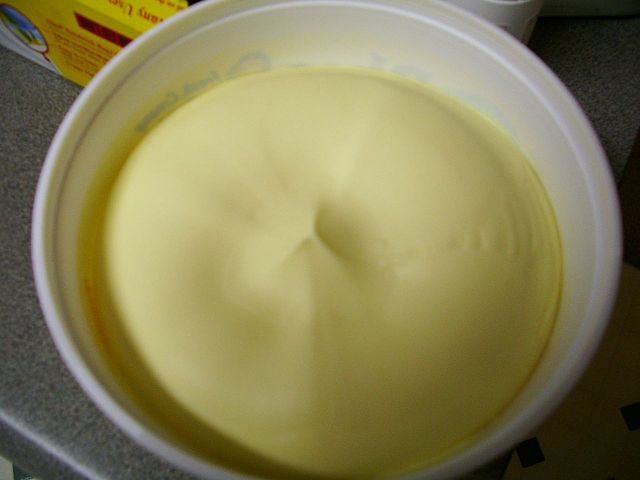Dye It

Margarine — sometimes called oleo — isn’t butter. While butter is made from butterfat (from milk), margarine comes from plant oils and often contains no dairy at all. It’s often cheaper as a result, and certainly was less expensive when it first became commercially available in the 1870s and 1880s. That made a lot of consumers happy, but it made the dairy industry very upset.
And they had political clout. Big Butter struck back so hard, Margarine went fluorescent.
The big problem butter producers had with margarine, if you took the industry at its word, was consumer confusion. Butter was a distinctive yellow color while margarine, naturally, was white, much like paste. (Butter, isn’t naturally yellow — its color is dependent on the feed of the cows from whose milk the butterfat comes, and often, butter has to be dyed yellow because of this. But let’s ignore that inconvenient truth for the time being.) Margarine producers were marketing their new product as a butter substitute — as good as the real McCoy, but cheaper! — and therefore, did whatever they could to make the two products seem similar. The butter lobby turned toward government to make sure this didn’t happen, arguing that butter was better and consumers shouldn’t be fooled by such trickery.
In 1877, the state of New York agreed, requiring retailers to provide written notice to consumers that what they were selling was margarine, and margarine wasn’t butter. Other states and ultimately the U.S. Federal government made similar requirements, passing the Margarine Act of 1886. (Yes, Congress passed a law titled the Margarine Act, and it was about butter substitute.) Under the act, margarine could only be produced with a license from the feds — one which most deemed expensive — and furthermore was taxed. The levy? Half a cent per pound for the naturally colored stuff and ten cents per pound if it were dyed yellow.
Those restrictions are pretty rough. Yet for many states, that didn’t go far enough. The initial solution: margarine makers were barred from making their faux-butter yellow.
This proved somewhat successful, but at least three states (per Smithsonian) went even further. New Hampshire, South Dakota, and Vermont each passed a law requiring that margarine be dyed pink, making it clear that it was not butter — and making it kind of gross, too. The Supreme Court overturned the pink laws, citing the laws’ effect on interstate commerce. But most other restrictions remained for decades.
Ultimately, through, World War II saved margarine from the not-so-buttery clutches of the dairy industry. Wartime restrictions on dairy made margarine more popular than ever, and by the late 1960s, the American laws restricting margarine sales were either revoked or deemed not worth enforcing.
Bonus Fact: The American War on Margarine, in retrospect, looks ridiculous — until you look at the Canadian War on Margarine. Margarine was banned in Canada entirely from 1866 (shortly after its commercial introduction) until 1917 due to dairy shortages, and then again from 1923 (when the dairy shortages abated) until 1948. Contraband, though, is difficult to eradicate, and a black market soon developed. Producers from the then-independent Dominion of Newfoundland gladly provided some to their non-butter to neighbors. When Newfoundland joined Canada in 1948, this lucrative business seemed to be at risk. Newfoundland’s negotiators, though, weren’t going to let it go. As Wikipedia sums up, “one of its three non-negotiable conditions for union with Canada was a constitutional protection for the new province’s right to manufacture margarine.” (The other two? That Canada would pay for a ferry service to and from Newfoundland, and that the region of Labrador would remain part of the now-province of Newfoundland.)
From the Archives: The Most Isolated People in the World: The main story is awesome but not about the above. The bonus fact is about Newfoundland.
Related: “The Butter Battle Book” by Dr. Seuss. (Which reminds me: does anyone really eat bread buttered side down?
